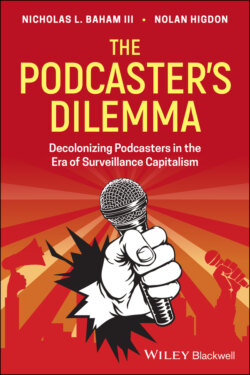Читать книгу The Podcaster's Dilemma - Nolan Higdon - Страница 8
Podcasting
ОглавлениеPodcasting and digital media are not only contemporaneous with the resurgence phase of community radio: they are a digital extension of modern community radio, particularly given their shared critique of and resistance to neoliberalism. Additionally, similar legislation and the growing accessibility of technology, which provided fertile ground for the resurgence of community radio, exist in the space of digital communication.21 With respect to technological access, King notes:
An additional factor aiding the rapid growth of community radio during the Resurgence period was the increasing accessibility and affordability of radio production and distribution technology. Prior to the 1990s, radio stations or producers wanting to share content either required an expensive connection (typically via satellite or high-grade phone line) or relied on shipping recordings through the mail. With the spread of the internet, new websites were launched like Radio4all.net and Archive.org, which went online in 1996, and Indymedia.org, created in 1999, for the free uploading and immediate distribution of audio files.22
Here King acknowledges the significant overlap between community radio and digital technologies, justifying not only the governing analogy of our project but also the notion that decolonizing podcasts are a contemporaneous outgrowth of the resurgence phase of King’s model, in technology as well as in substance.
Our insistence on the analogous nature of radio and digital communication is supported in much of the emerging critical literature on digital communication. For example, Tiziano Bonini’s analysis of the polymedia intermingling of radio and social media during the 2013 Gezi Park protests in Turkey suggests profound continuities between old and new technologies in resistance and decolonization movements. Bonini writes:
Radio has been employed as a communication tool during all the social movements and protests of the last decades of the past century, from the student movements of May 1968 in Paris and Mexico City to the 1999 Seattle WTO protests, while the political protests and uprisings at the beginning of the twenty-first century have mostly been supported by social media … Is Twitter the radio of the twenty-first century? Another, more complex, reality lies beyond the surface of the representation of the protests shaped by the mainstream media: the mediascape in which political movements such as Occupy, the Arab Spring and the Indignados have emerged is a mixed one, a mediascape where old and new, mainstream and underground media co-exist, interact and shape each other.23
In 2020 Andrew J. Bottomley documented the stages of podcasting in his book the Sound Streams: A Cultural History of Radio–Internet Convergence, just as King had done for radio.24 Bottomley argues that there are three waves of podcasting. The first wave, from 2000 to 2005, witnessed the unnamed practice of podcasting emerge as an auditory version of the unconventional practice of blogging. The second wave, from 2005 to 2010, introduced repurposed radio content, user-generated round table discussions, and comedic content as podcasting. And the third wave, which began in 2010, saw more in-depth storytelling, which Bottomley credits to the investigative journalism podcast Serial.25 Bottomley argues that in the second wave the term podcasting was coined as a result of an association with the iPod, coupled with Apple’s monopoly of podcasting content at the time.26 Beyond Bottomley, the existing scholarship has been limited to multicontributor volumes about podcast culture and about the popularity and format of podcasts, and to methodological texts for research on podcasts.27
